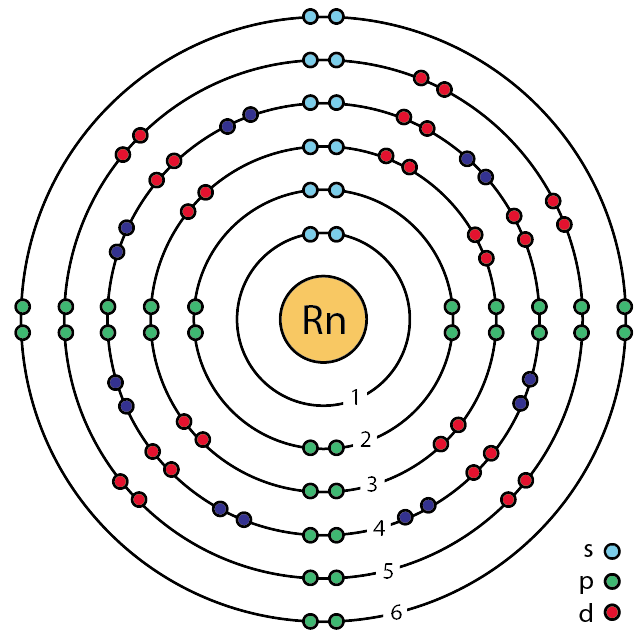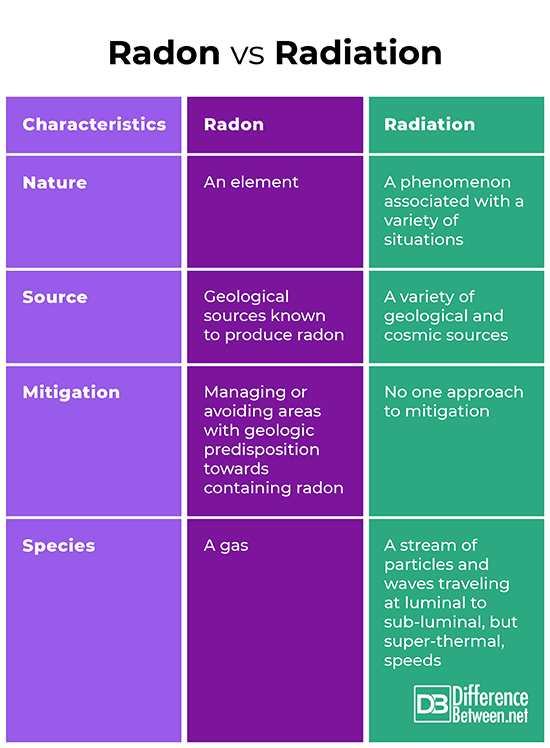Difference Between Radon and Radiation
What is Radon?
Radon is one of the noble gases. It is number 86 on the periodic table. Radon is one of the elements known for being radioactive. The isotope of radon with the longest half-life is radon 222, which has a half-life of about 3.8 days. It is produced as a result of the decay of uranium, thorium, and radium. It is the direct daughter product of radium.
Radon is a noble gas, so it does not combine chemically with other elements except in unusual circumstances. It becomes a liquid at -61.8 degrees Celsius or -79.2 degrees Fahrenheit. If temperatures drop below -71 degrees Celsius or -96 degrees Fahrenheit, it freezes into a solid.
Radon is generally very rare since its isotopes are short-lived. Radon is also unusual in being a radioactive element that is a gas at room temperature. Since the gas is radioactive, it is also known to be a cancer risk.
The fact that radon is a gas also makes it dangerous since it can easily seep through the ground and into buildings. This is especially common in areas with minerals containing uranium. In addition to moving within the air-filled pore spaces in soil and rock. Radon gas can also be carried by ground water and contaminate wells.
Radon is not known to play any biological role, but because of its radioactive attributes and the ease with which it can spread through the environment, it may have had a significant impact on the evolution of life because of its mutagenic properties in living organisms.
What is Radiation?
Radiation refers to the flow of waves and particles that flow at the speed of light, or a speed that is less than the speed of light but greater than thermal velocities.
Matter radiation vs. electromagnetic radiation
Radiation can be broadly divided into electromagnetic rays and matter rays. Electromagnetic rays travel at the speed of light and do not have any mass when they are, theoretically, at rest. Matter rays refer to radiation that travels at velocities greater than thermal velocities but slower than the speed of light. Waves and particles fit into both categories because of the dual nature of light as a wave and a particle. Essentially, light behaves as a wave under certain conditions and as a particle under other conditions. There are also situations where matter will behave as a particle under some conditions and as a wave under other conditions at the sub-atomic level.
For this reason, matter rays and electromagnetic rays are not distinguished by saying one is a particle and one is a wave, but by whether or not they have rest mass and their propagation speed.
Electromagnetic rays consist of the radiation on the electromagnetic spectrum. This radiation includes gamma rays, X-rays, ultraviolet rays, visible light, infrared, radio, microwaves, etc. Electromagnetic rays are important for astronomy since they often come from cosmic sources, though all objects emit some form of electromagnetic radiation depending on their level of energy. Extremely energetic phenomena will emit high energy electromagnetic rays. Very low energy phenomena will emit low energy electromagnetic radiation. A black hole, for example, is a high energy phenomenon since it produces X-rays. Planetary atmospheres, on the other hand, tend to be relatively cold and will usually emit low energy electromagnetic radiation, such as infrared.
Matter rays will consist of high energy protons, neutrons, and electrons. These rays include solar wind produced by the sun. They also include most forms of radiation resulting from radioactive decay of elements, such as uranium and thorium. Radioactive decay occurs when an unstable nucleus decays by emitting particles and electromagnetic radiation to become a stable nucleus. Although radioactive decay involves matter rays, electromagnetic radiation, namely gamma rays, can also be emitted during the process of radioactive decay.
Effects on society and health
Radiation of both types is known to damage biological cells and tissue and cause mutations. Although some of these mutations can be beneficial and allow for an organism to better adapt to its environment, many of them are harmful. These include the mutations that lead to cancer.
Similarities between radon and radiation
Both radon and radiation pose health risks to human societies. They also both involve a flow of particles and waves. For radon, this flow of particles and waves consists of the radiation that results from the decay of radon into its daughter products.
Differences between radon and radiation
Although there are notable similarities between radon and radiation, there are also important differences which include the following.
- Radon is a specific element that is known to produce radiation through radioactive decay, whereas radiation is a phenomenon that occurs in a variety of situations.
- Radon comes from specific geological formations containing minerals that are rich in certain radioactive elements, such as uranium. Radiation, on the other hand, can come from a variety of sources both geological and non-geological.
- Radon exposure can be mitigated by managing or avoiding areas known to be geologically predisposed to containing significant amounts of radon, such as geologic provinces containing uranium-bearing minerals. On the other hand, there is no one way to prevent exposure to radiation in general.
- Radon is a gas made up of specific atoms, whereas radiation consists of a flow of waves and particles at speeds at or below the speed of light and greater than thermal speeds.
Radon vs. Radiation
Summary
Radon is a noble gas that is known to be radioactive and results from the decay of radium, uranium, and thorium. Radon 222, the most long-lived isotope of radon, has a half-life of 3.8 days. Radon is considered to be dangerous to human health because its radiation has been connected to cancer. It also may have significantly influenced the evolution of life on Earth because of its mutagenic properties and tendency to spread easily through pores in rock and soil and through groundwater. Radiation is a stream of particles and waves that travel at the speed of light or slower, but faster than thermal velocities. Radiation is caused by electromagnetic rays which do not have rest mass and travel at the speed of light and matter rays which do have rest mass but that do not travel at the speed of light. Radiation and radon are similar in that both involve streams of particles. Both are also significant health risks. They differ, however, in that radon is a specific gas which is associated with certain geologic contexts, while radiation is a phenomenon where streams of particles and waves travel faster than thermal velocities and up to the speed of light. Radiation is also associated with a variety of elements and a variety of sources which can be geological or cosmic.
- Difference Between Environmental Performance Index and Development - November 24, 2023
- Difference Between Environmental Intervention and Development - November 8, 2023
- Difference Between Eco Efficiency and Eco Effectiveness - September 18, 2023
Search DifferenceBetween.net :
Leave a Response
References :
[0]Crossfield, Ian James Mills. Infrared Observations of Exoplanet Atmospheres. Diss. UCLA, 2012. Available at: https://escholarship.org/uc/item/06s2n5qp
[1]Klesman, Alison. “X-ray light reveals the geometry of a black hole.” Astronomy.com, http://www.astronomy.com/news/2018/07/cygnus-x-1-polarimetry. Accessed 20 December 2019.
[2]Pederson, Traci. “Facts about Radon.” Live Science, https://www.livescience.com/39546-radon.html. Accessed 20 December 2019.
[3]Rasmussen, John O., and Ellis P. Steinberg. “Radioactivity.” Encyclopedia Britannica. Encyclopedia Britannica, inc. November 1, 2019. Available at: https://www.britannica.com/science/radioactivity
[4]Tate, Jean. “Radioactive Decay.” Universe Today, https://www.universetoday.com/61897/radioactive-decay/. Accessed 20 December 2019.
[5]The Editors of Encyclopedia Britannica. “Radon.” Encyclopedia Britannica. Encyclopedia Britannica, inc. April 25, 2019. Available at: https://www.britannica.com/science/radon
[6]Tobias, Cornelius A., and Asokendu Mozumder et al. “Radiation.” Encyclopedia Britannica. Encyclopedia Britannica, inc. April 14, 2017. Available at: https://www.britannica.com/science/radiation https://escholarship.org/uc/item/06s2n5qp
[7]“What is solar wind?” Space Environment, N.D., http://www.qrg.northwestern.edu/projects/vss/docs/space-environment/3-what-is-solar-wind.html.
[8]Image credit: https://live.staticflickr.com/2074/1956910073_ded4e59135_z.jpg
[9]Image credit: https://commons.wikimedia.org/wiki/File:86_radon_(Rn)_enhanced_Bohr_model.png



